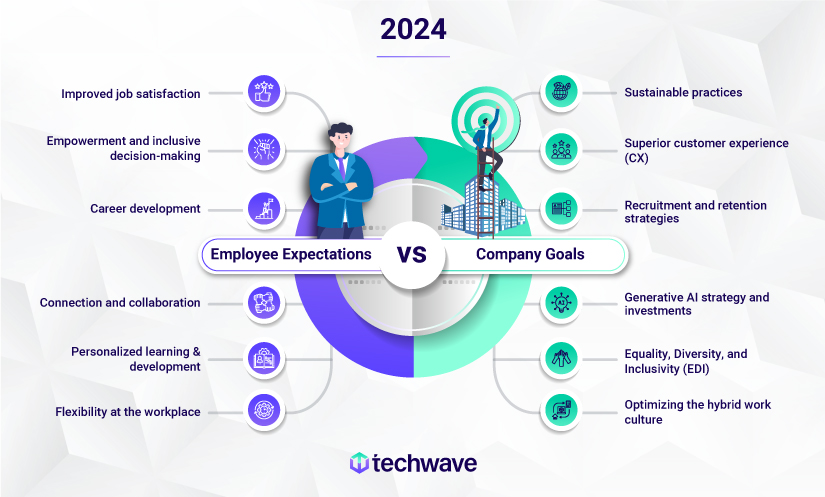
“Where do you see yourself in five years?”
Since childhood, this question has been a cue for us to look into our souls, ponder our dreams and goals, and carve our paths. In 2024, companies are mulling over a similar question: How do they navigate investments in critical focus areas and employee goals to ensure the envisioned success in five years?
The last three years have triggered a quintessential shift in the corporate sphere, with 86% of employees prioritizing meaningfulness in their work. As a tech start-up founder aptly said, “How you treat your colleagues is arguably more important than the messages you share internally and externally.”
However, the reality is – leaders are caught in a suffocating vise. On one side, ever-escalating demands: revenue targets, performance benchmarks, and customer loyalty. On the other, the talent war, with employees now assertive and demanding a more agreeable work environment. Managers juggle this pressure, desperately accommodating everything from social justice alignment and remote work to extended leave and mental health support.
Here’s a snapshot of employee expectations vs. company goals in 2024.

If you notice, the employee expectations directly translate into:
- Am I content? – Employees seek a high level of contentment in their jobs; this transcends monetary considerations and is more aligned with a sense of belonging and loyalty to the company.
- Am I empowered? – Employees want to be heard and valued. They want the organizations’ choices to result from diverse perspectives and ideas.
- Do my ambitions matter to the company? – Employees want companies to recognize their ambitions for higher positions and help them reach their goals. This motivates and stimulates them to work harder and smarter.
- Do I feel connected? – With jobs going remote, employees demand experiences that will help them build a connection with colleagues to enhance workplace collaboration and camaraderie.
- Does the training offered align with my aspirations? – Employees want customized learning in alignment with their skills and aspirations. They also want training and upskilling in AI and data management to future-proof their jobs.
- Can I choose my work mode as per my situation? – Employees demand a hybrid model to help them balance their personal and professional lives. The Randstad 2023 Work monitor data revealed that more than three-quarters of those surveyed insisted on this as a non-negotiable factor.
On the other hand, for the most part, businesses face more than the traditional challenges of increasing sales, improving margins, and expanding market share, spanning genAI, implementing sustainable initiatives to a hybrid workforce to a shortage of skilled talent.
The challenge is that company goals and objectives that aim to push growth in all directions may sometimes appear misaligned with employee ambitions and aspirations. So, the question is – Can companies truly create a workplace where delivering the best customer and employee experience isn’t just a slogan hung up on mood boards but a shared harmony of aspirations?
Meeting Employee Needs and Achieving the Organization’s Goals: Finding that Delicate Balance
It is justified to support human-centered leadership and policies. However, regardless of the buzz around employee experiences and satisfaction, let’s not forget we have a business to run – the same business enabling employee benefits!
Investing in people is a solid strategy, but within reason. The point where you start unreasonably over-emphasizing in a bid to satisfy each individual while compromising on the viability of your business is when you start feeling threatened by failure. It’s like pushing a child’s swing: push it just right, and it soars in delight. Push too far; control takes flight!
So, what’s the best way for a company to embrace both sides in a manner that benefits everyone? Here are a few tips.
1. Embrace clarity and flexibility (within reason)
Instead of leaving boundaries ambiguous, paint a clear picture of flexibility from the outset. For example, imagine granting three remote days a week but emphasizing that Wednesdays are dedicated to in-office teamwork, nurturing collaboration, and face-to-face connections. This transparent framework shows you value both individual autonomy and team synergy.
Remember, flexibility has edges. Define those edges explicitly. Like the Wednesday rule ensures collaboration, you might clarify which projects require on-site attendance or set reasonable expectations for response times during remote days. Outlining these parameters empowers your team to plan effectively and avoid confusion.
2. Demystify business: A recipe for trust and alignment
Transparency is the secret ingredient in building a trusting and aligned team. Consider inviting your employees to the table instead of keeping financials behind a locked door. Imagine sharing key metrics, like sales figures or cost breakdowns, alongside your growth strategy. This open kitchen empowers them to see the complete picture, understanding how their roles contribute to the bigger pie.
For example, sharing year-end profitability with a marketing team alongside ambitious growth targets helps them grasp the importance of exceeding their campaign goals. This context not only fuels motivation but also fosters realistic expectations. They’ll understand why a lavish office remodel might hold off for a quarter, making budget-conscious suggestions like remote team-building events instead.
Remember, a team in the dark is likelier to bake unrealistic expectations, setting themselves and the company up for disappointment.
3. Encourage ownership and discover engagement
Imagine a team that’s not just ticking off tasks but creating the framework for those tasks. That’s the transformative power of ownership . Rather than overseeing every detail, define a clear end goal – one that’s ambitious yet attainable. Then, empower your team with the necessary resources, support, and the liberty to navigate their own path. The benefits of this approach? A team that’s not only more engaged but one that takes ownership, leading to enhanced productivity.
Consider a marketing team tasked with amplifying brand visibility. Rather than prescribing specific campaigns, allocate the budget, supply the research data, and grant access to creative tools. Then, allow them to ideate, test, and even propose groundbreaking ideas that exceed your original expectations. The outcome? Not just heightened brand visibility but a team filled with ownership, drive, and a feeling of collective triumph. This freedom empowers them, making them feel trusted and valued.
Admittedly, total independence isn’t always feasible. However, wherever you can afford to ease control, the benefits are numerous and significant. As Dr. Steve Kerr (former Chief Learning Officer at General Electric and Goldman Sachs) stated, “If you want something to happen, you have to make people able and you have to make them want to”.
4. Say NO with grace: Balancing respect and boundaries
Even the most open-door policy has limits. When employees approach with concerns or requests, hear them entirely, but be ready to hold your ground if they ask for something that doesn’t align with sustaining the business.
Explain with compassion why it’s not feasible: balance honesty with understanding. Frame your “no” within the bigger picture – resources, goals, or team impact. Offer alternatives when possible (flexibility instead of full remote) to show you’re invested in solutions, not just saying no.
Finally, respect the relationship. Your tone and body language should convey empathy, even when saying no. Acknowledge their feelings, validate their concerns, and ensure they feel heard. A “no” delivered with grace strengthens trust, paves the way for future collaboration, and proves you’re a leader who handles difficult situations with care and consideration.
Remember, a business cannot run on dictatorship or succeed in a democratic model. In 2024, leaders must channel their employees’ voices and capitalize on diverse ideas while never losing sight of the ultimate goal.
These tips are as much a support for employees as for leaders. After all, success with contentment comes with mutual understanding and not at the cost of sacrificing one for the other.
At Techwave , we believe in the power of empowerment. We have always championed businesses built on equity, empathy, and authentic purpose. In 2024, we’re doubling down on “Empower Success” . Why? Because in a world craving trust and connection, businesses that empower people, including – clients, colleagues, and community, and share goals will not just survive, they’ll thrive.
